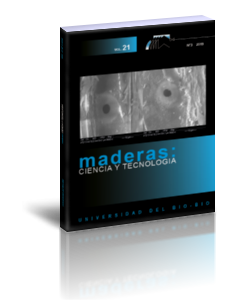Effect of brown rot degradation on mass loss and compressive strength of chinese poplar (Populus simonii)
Keywords:
Biodeterioration, decay fungi, Gloeophyllum trabeum, mechanical properties, Populus simoniiAbstract
The wood of poplar species are generally perceived as susceptible to decay, however, poplar is still widely used as columns in traditional Chinese buildings. Understanding how decay affects the compressive properties of this material will help engineers better assess wood condition during routine inspection and maintenance. The effects of decay on compressive properties of Chinese poplar were explored using a brown rot decay fungus (Gloeophyllum trabeum). Changes in compression strength were fairly linear and more closely correlated with mass loss (R2= 0.75). The results suggest that residual compressive strength could be roughly predicted using wood density as a surrogate measure.
Downloads
References
AQSIQ. SAC. 2009b. Method of testing in compressive strength parallel to grain of wood. GB/T 1935-2009. AQSIQ. SAC: Beijing, China.
ASTM International. 2001. Standard method of accelerated laboratory test of natural decay resistance of woods. ASTM D-2017. 2001. In: ASTM Annual Book of Standards, Volume 4.10 Wood. ASTM: West Conshohocken, PA. p.322-326.
Bari, E.; Sistani, A.; Taghiyari, H.R.; Morrell, J.J.; Cappellazzi, J. 2017. Influence of test method on biodegradation of bamboo-plastic composites by fungi. Maderas-Cienc Tecnol 19(4): 455-462.
Brischke, C.; Welzbacher, C.R.; Huckfeldt, T. 2008. Influence of fungal decay by different basidiomycetes on the structural integrity of Norway spruce wood. Holz als Roh und Werkstoff 66:433-438.
Curling, S.F.; Clausen, C.A.; Winandy, J.E. 2002. Experimental method to quantify progressive stages of decay of wood by basidiomycete fungi. International Biodeterioration & Biodegradation 49: 13-19.
Forest Products Laboratory. 2010. Wood Handbook: Wood as an Engineering Material. General Technical Report FPL-GTR-190. USDA Forest Products Laboratory: Madison, WI. 509p.
Ge, X.W.; Wang, L.H.; Hou, J.J.; Rong, B.B.; Yue, X.Q.; Zhang, S.M. 2016. Relationship among microstructure, mechanical properties and chemical compositions in Populus cathayana sapwood during brown-rot decay. Journal of Beijing Forestry University 38(10): 112-122.
Jin, Z.W.; You, J.X.; He, W.L.; Li, Y.J. 1988. Research on degradation and protection of Poplar wood. J Nanjing Forestry Univ 12:66-73.
Li, X.P.; Leavengood, S.; Cappellazzi, J.; Morrell, J.J. 2018. Laboratory decay resistance of palmyra palm wood. Maderas-Cienc Tecnol 20(3): 353-358.
Malda, K.; Ohta, M.; Momohara, I. 2015. Relationship between the mass profile and the strength property profile of decayed wood. Wood Sci Technol 49: 331-344.
Wilcox, W.W. 1978. Review of the literature on the effects of early stages of decay on wood strength. Wood and Fiber 9(4):252-257.
Winandy, J.E.; Morrell, J.J. 1993. Relationship between incipient decay, strength, and chemical composition of Douglas-fir heartwood. Wood Fiber Sci 25:278-288.
Witomski, P.; Olek, W.; Bonarski, J.T. 2016. Changes in strength of Scots pine wood (Pinus silvestris L.) decayed by brown rot (Coniophora puteana) and white rot (Trametes versicolor). Construction and Building Materials 102: 162-166.
Yang, Z.; Jiang, Z.H.; Fei, B.H. 2006. Review of literature on incipient decay in wood. Scientia Silvae Sinicae 42:99-103.
Zabel, R.A.; Morrell, J.J. 1992. Wood microbiology. Academic Press: San Diego, CA. 476 pages.

































